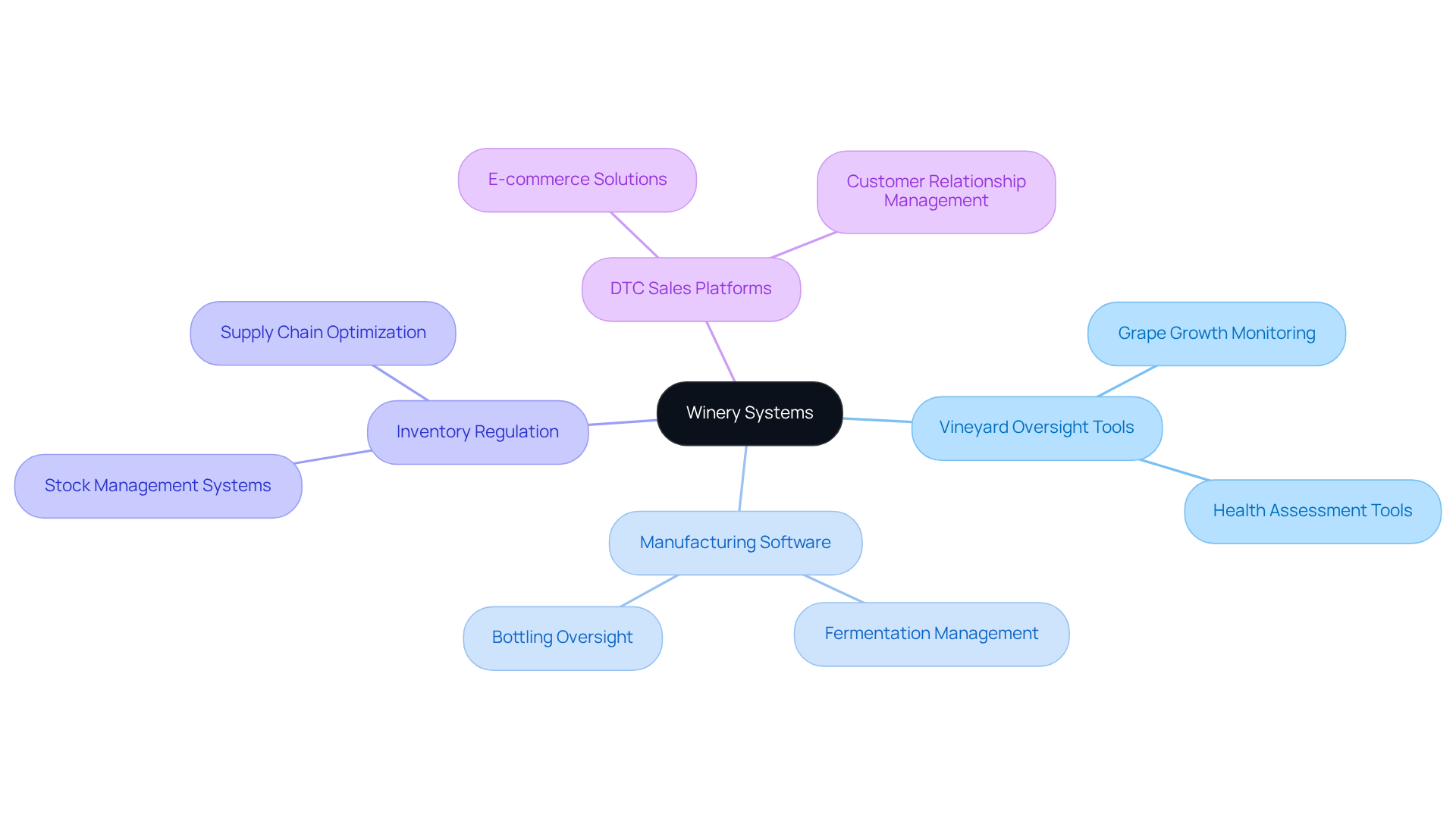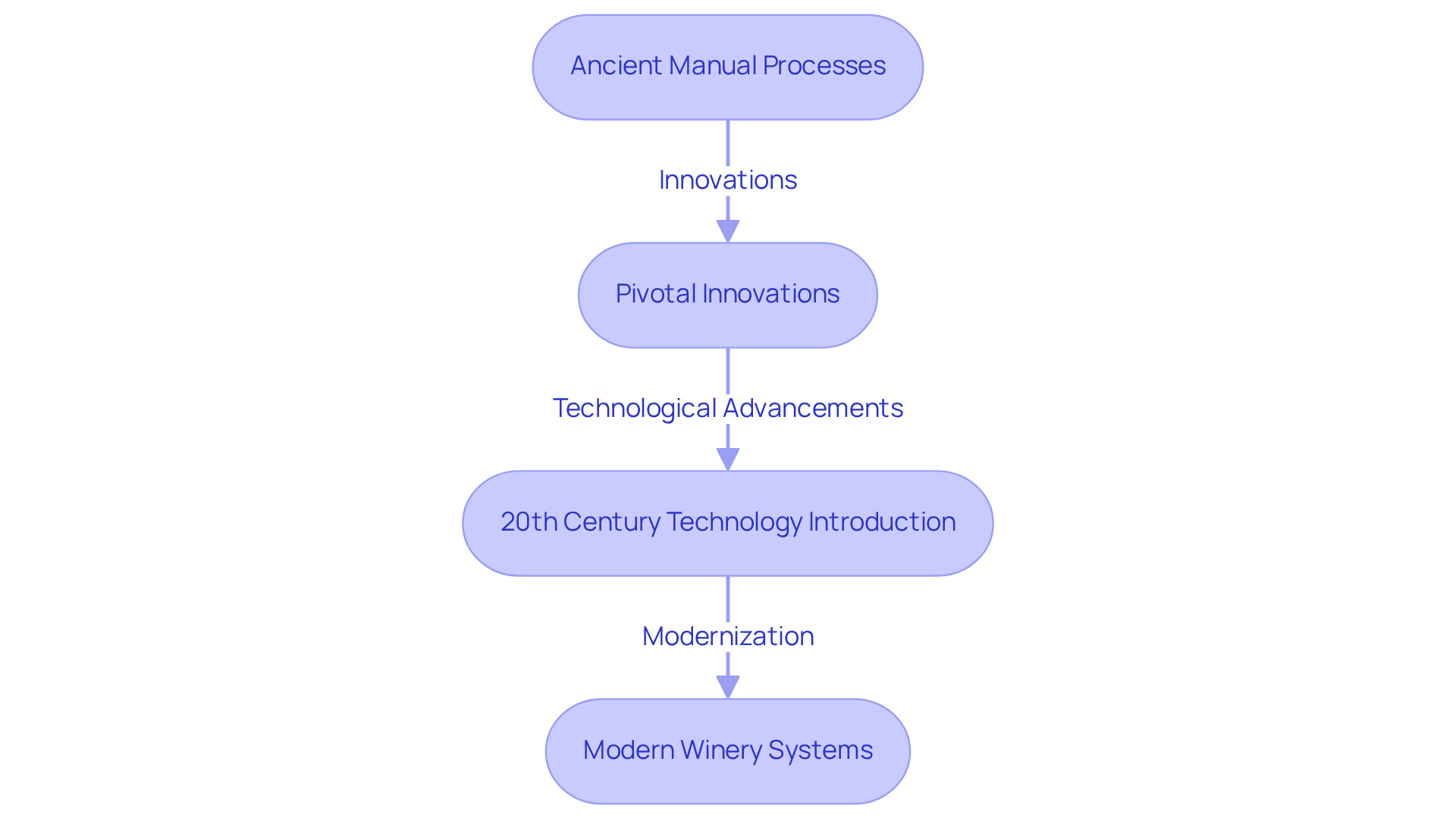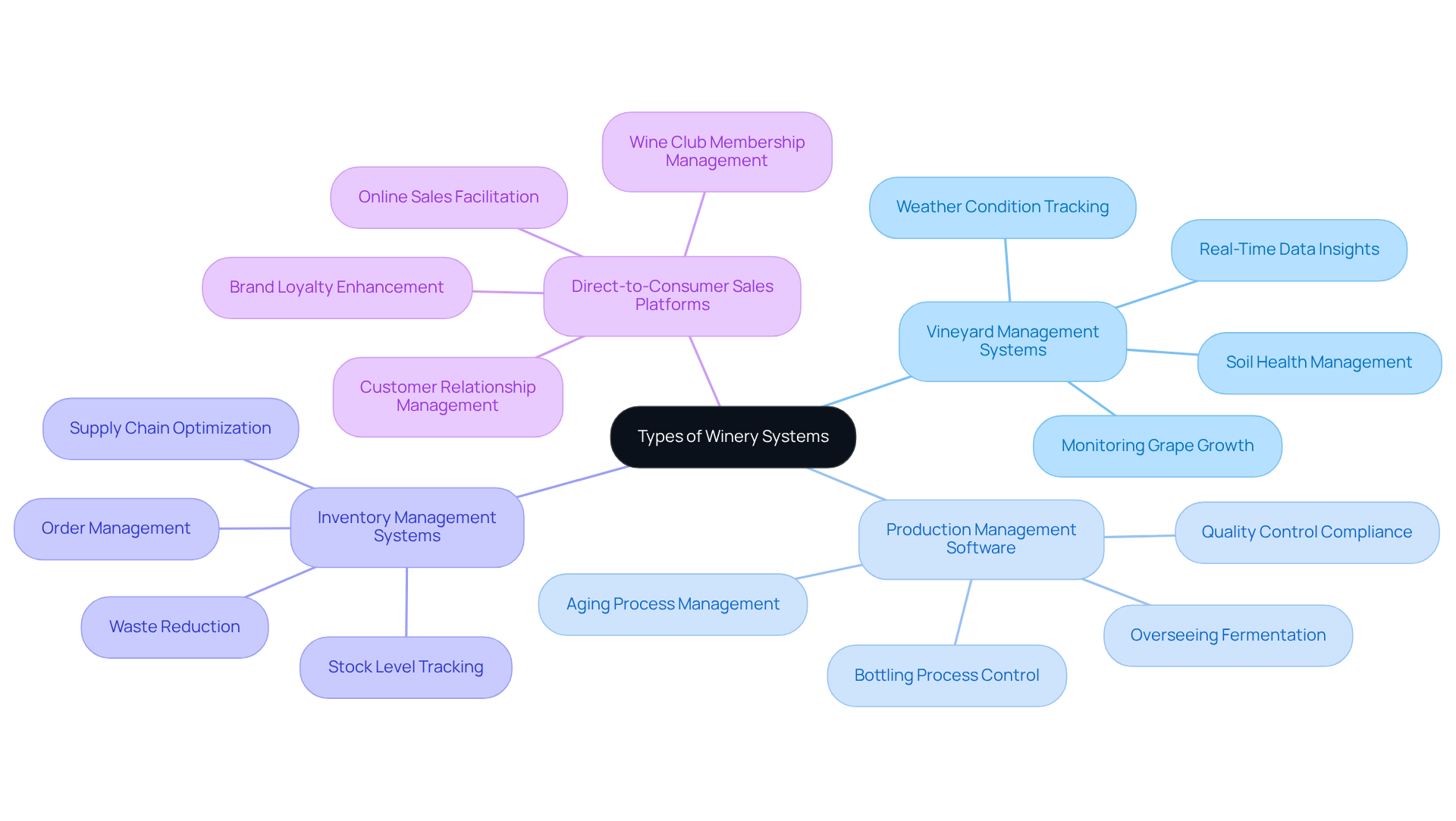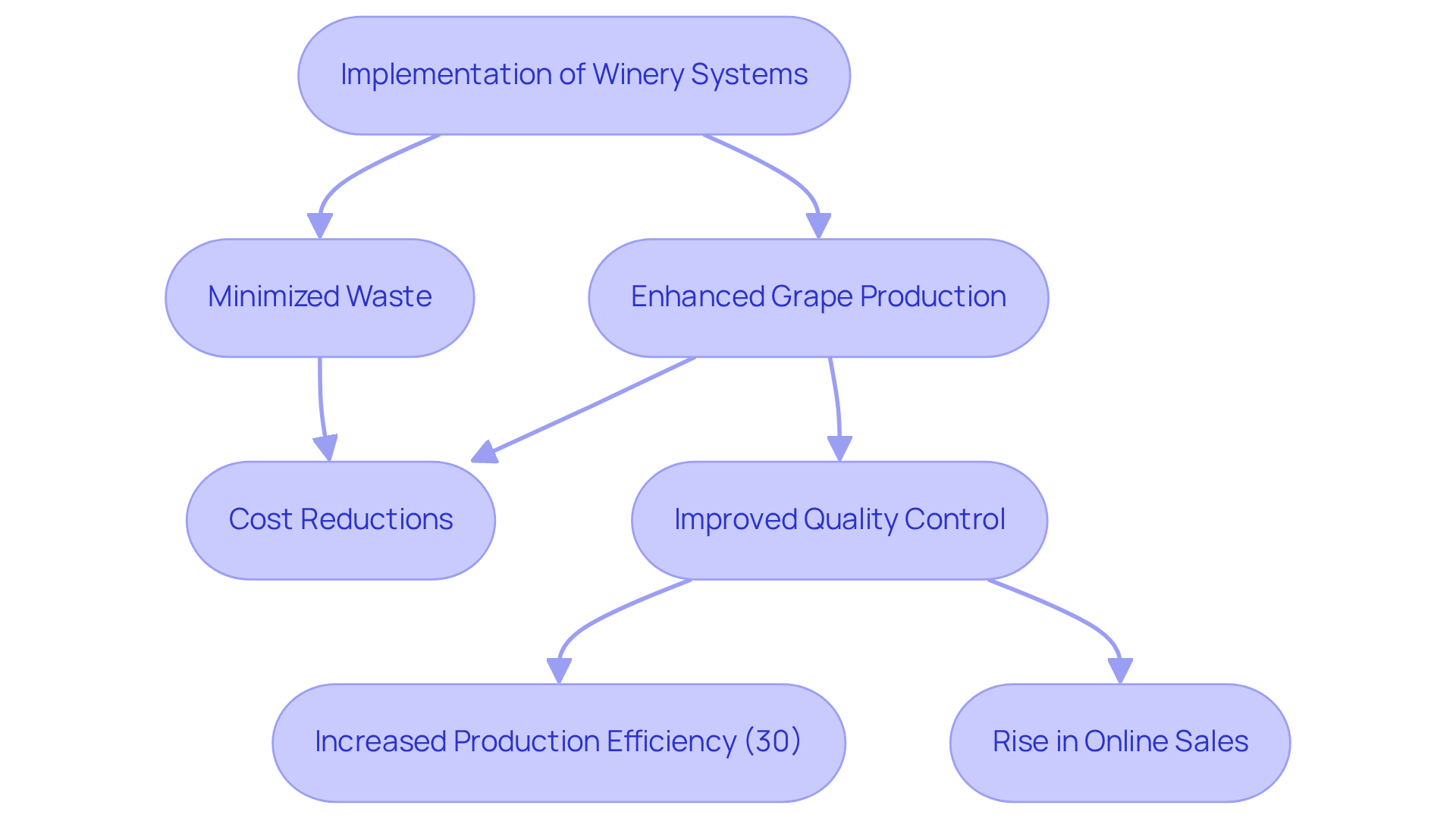Overview
Winery systems represent integrated processes and technologies that significantly enhance the production, management, and distribution of wine. By focusing on direct-to-consumer (DTC) strategies, these systems foster customer loyalty and drive revenue growth. This article illustrates that through the utilization of various systems—such as vineyard management, production software, and DTC sales platforms—wineries can optimize their operations. This optimization not only improves product quality but also leads to a substantial boost in market success.
The implementation of these systems is crucial for wineries aiming to thrive in a competitive landscape. By embracing innovative technologies and strategies, they position themselves to better meet consumer demands and enhance overall efficiency. The evidence suggests that wineries leveraging these integrated systems are better equipped to navigate the complexities of the wine market, ultimately leading to increased profitability and customer satisfaction.
In conclusion, the adoption of winery systems is not merely an operational enhancement; it is a strategic imperative for any winery looking to secure its future in the industry. By investing in these technologies, wineries can ensure they remain at the forefront of market trends, delivering quality products that resonate with consumers and drive long-term success.
Introduction
Winery systems serve as the backbone of modern winemaking, integrating a diverse array of processes and technologies that streamline production and enhance customer engagement. These systems not only bolster operational efficiency but also empower wineries to forge enduring relationships with consumers through direct-to-consumer sales strategies.
As the industry evolves with rapid technological advancements, the pressing question arises: how can wineries effectively leverage these systems to remain competitive and satisfy the growing demands of discerning wine lovers?
Defining Winery Systems: Core Components and Functions
Winery systems encompass a diverse array of integrated processes and technologies that facilitate the creation, oversight, and distribution of wine, placing a significant emphasis on direct-to-consumer (DTC) strategies. These essential elements include:
- Vineyard oversight tools
- Manufacturing software
- Inventory regulation
- DTC sales platforms
All integrated into winery systems designed to generate reliable revenue and foster customer loyalty. By collaborating, these winery systems optimize processes, enhance effectiveness, and elevate the quality of the final product. For instance, vineyard management tools play a crucial role in monitoring grape growth and health, while production software meticulously oversees fermentation and bottling processes. Through the implementation of , vineyards have the potential to transform casual buyers into loyal club members, ensuring sustainable growth and the capacity to respond adeptly to market demands.

The Evolution of Winery Systems: Historical Context and Modern Relevance
The evolution of vineyard systems is deeply rooted in ancient winemaking practices, where manual processes reigned supreme. Over the centuries, pivotal innovations such as fermentation tanks and bottling lines have fundamentally transformed production methods. The 20th century marked a significant turning point with the introduction of computer technology, which revolutionized vineyard operations through the development of specialized software for inventory management and sales tracking. Today, leverage technologies such as automation, data analytics, and cloud computing, empowering wineries to enhance operational efficiency and elevate customer experiences. This ongoing evolution is a direct response to the rising expectations of consumers and the competitive pressures within the industry.

Types of Winery Systems: Key Variations and Their Roles
Winery systems include several , each designed to fulfill specific functions crucial for operational success. These include:
- Vineyard Management Systems: Vital for monitoring grape growth, soil health, and weather conditions, these systems provide real-time data that empower vineyards to make informed decisions. Such insights enhance cultivation practices and optimize grape quality, ultimately contributing to superior wine production.
- Production Management Software: This software plays a critical role in overseeing fermentation, aging, and bottling processes. By ensuring stringent quality control and compliance with industry standards, it directly influences the final product's quality. Notably, case studies reveal that vineyards utilizing advanced production management software experience significant improvements in wine quality and consistency.
- Inventory Management Systems: These systems adeptly track stock levels, manage orders, and optimize supply chain logistics. By streamlining operations, they assist vineyards in maintaining optimal inventory levels, thereby reducing waste and enhancing profitability.
- Direct-to-Consumer (DTC) Sales Platforms: Facilitating online sales, wine club memberships, and customer relationship management, these platforms enable vineyards to connect directly with consumers. This direct engagement fosters brand loyalty and stimulates revenue growth.
The integration of these winery systems not only enhances operational effectiveness but also increases market adaptability, positioning vineyards for success in a competitive landscape. Particularly, the role of vineyard oversight is essential in ensuring that quality control practices are woven throughout the winemaking process, culminating in exceptional wine products.

Impact of Winery Systems on Production Efficiency and Market Success
The establishment of efficient vineyard operations significantly influences both production effectiveness and market success. By employing winery systems for vineyard oversight, establishments can enhance grape production and minimize waste, leading to substantial cost reductions. Moreover, production oversight software improves quality control, ensuring that every bottle meets consumer expectations.
Direct-to-consumer (DTC) sales platforms enable producers to forge direct relationships with consumers, fostering loyalty and encouraging repeat business. Industry reports reveal that establishments implementing comprehensive management approaches experience an average increase in production efficiency of 30% alongside a notable rise in online sales. This evidence underscores that is more than just an operational necessity; it represents a strategic move poised to drive long-term growth.

Conclusion
Winery systems stand as a pivotal framework that integrates diverse processes and technologies vital for wine production, management, and sales. Understanding these systems reveals their role in enhancing operational efficiency and fostering consumer loyalty, ultimately shaping the success of vineyards within a competitive industry.
This article explores the core components of winery systems, emphasizing the importance of:
- Vineyard management tools
- Production software
- Inventory systems
- Direct-to-consumer sales platforms
Each element is crucial for ensuring quality control, optimizing grape cultivation, and streamlining operations, collectively contributing to improved production efficiency and market success. The historical evolution of these systems highlights the transformative impact of technology, illustrating how advancements have consistently elevated winemaking practices.
As the wine industry navigates ever-changing consumer expectations and market dynamics, the adoption of integrated winery systems is not merely beneficial; it is essential for sustained growth. By investing in these systems, wineries can enhance their production capabilities and cultivate stronger relationships with consumers, ensuring long-term success in an increasingly competitive landscape. The future of winemaking hinges on the effective utilization of these tools, making it imperative for vineyards to adapt and innovate in their operations.
Frequently Asked Questions
What are winery systems?
Winery systems are integrated processes and technologies that facilitate the creation, oversight, and distribution of wine, focusing on direct-to-consumer (DTC) strategies.
What are the core components of winery systems?
The core components of winery systems include vineyard oversight tools, manufacturing software, inventory regulation, and DTC sales platforms.
How do winery systems contribute to revenue generation?
Winery systems are designed to generate reliable revenue by optimizing processes, enhancing effectiveness, and fostering customer loyalty.
What role do vineyard management tools play in winery systems?
Vineyard management tools monitor grape growth and health, which is crucial for ensuring the quality of the final product.
How does production software function within winery systems?
Production software oversees fermentation and bottling processes, ensuring meticulous management of wine production.
What is the significance of direct-to-consumer (DTC) strategies in winery systems?
DTC strategies help transform casual buyers into loyal club members, ensuring sustainable growth and the ability to respond to market demands.




